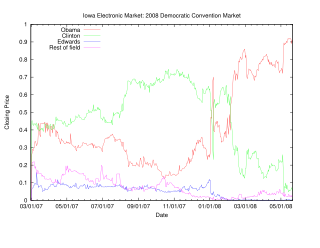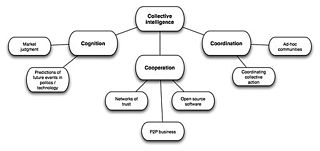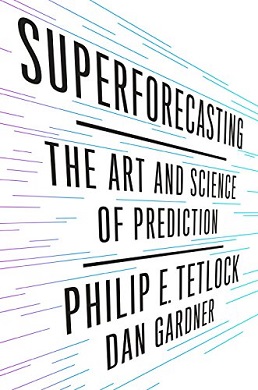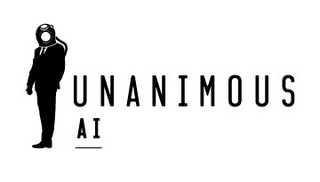Forecasting is the process of making predictions based on past and present data. Later these can be compared (resolved) against what happens. For example, a company might estimate their revenue in the next year, then compare it against the actual results creating a variance actual analysis. Prediction is a similar but more general term. Forecasting might refer to specific formal statistical methods employing time series, cross-sectional or longitudinal data, or alternatively to less formal judgmental methods or the process of prediction and resolution itself. Usage can vary between areas of application: for example, in hydrology the terms "forecast" and "forecasting" are sometimes reserved for estimates of values at certain specific future times, while the term "prediction" is used for more general estimates, such as the number of times floods will occur over a long period.
The Policy Analysis Market (PAM), part of the FutureMAP project, was a proposed futures exchange developed, beginning in May 2001, by the Information Awareness Office (IAO) of the United States Defense Advanced Research Projects Agency (DARPA), and based on an idea first proposed by Net Exchange, a San Diego, California, research firm specializing in the development of online prediction markets. PAM was shut down in August 2003 after multiple US senators condemned it as an assassination and terrorism market, a characterization criticized in turn by futures-exchange expert Robin Hanson of George Mason University, and several journalists. Since PAM's closure, several private-sector variations on the idea have been launched.
Prediction markets, also known as betting markets, information markets, decision markets, idea futures or event derivatives, are open markets that enable the prediction of specific outcomes using financial incentives. They are exchange-traded markets established for trading bets in the outcome of various events. The market prices can indicate what the crowd thinks the probability of the event is. A typical prediction market contract is set up to trade between 0 and 100%. The most common form of a prediction market is a binary option market, which will expire at the price of 0 or 100%. Prediction markets can be thought of as belonging to the more general concept of crowdsourcing which is specially designed to aggregate information on particular topics of interest. The main purposes of prediction markets are eliciting aggregating beliefs over an unknown future outcome. Traders with different beliefs trade on contracts whose payoffs are related to the unknown future outcome and the market prices of the contracts are considered as the aggregated belief.
The Delphi method or Delphi technique is a structured communication technique or method, originally developed as a systematic, interactive forecasting method that relies on a panel of experts. The technique can also be adapted for use in face-to-face meetings, and is then called mini-Delphi. Delphi has been widely used for business forecasting and has certain advantages over another structured forecasting approach, prediction markets.
Swarm intelligence (SI) is the collective behavior of decentralized, self-organized systems, natural or artificial. The concept is employed in work on artificial intelligence. The expression was introduced by Gerardo Beni and Jing Wang in 1989, in the context of cellular robotic systems.

James Michael Surowiecki is an American journalist. He was a staff writer at The New Yorker, where he wrote a regular column on business and finance called "The Financial Page".
Herd mentality is the tendency for people’s behavior or beliefs to conform to those of the group they belong to. The concept of herd mentality has been studied and analyzed from different perspectives, including biology, psychology and sociology. This psychological phenomenon can have profound impacts on human behavior.
All telecommunications service providers perform forecasting calculations to assist them in planning their networks. Accurate forecasting helps operators to make key investment decisions relating to product development and introduction, advertising, pricing etc., well in advance of product launch, which helps to ensure that the company will make a profit on a new venture and that capital is invested wisely.

The Iowa Electronic Markets (IEM) are a group of real-money prediction markets/futures markets operated by the University of Iowa Tippie College of Business. Unlike normal futures markets, the IEM is not-for-profit; the markets are run for educational and research purposes.
Prediction markets company NewsFutures (2000-2010) evolved into Lumenogic (2010-2019), "a consulting firm that specializes in developing and customizing online systems for large organizations to use to gather so-called Collective Intelligence from their employees", which in turn became Hypermind (2019-).
Collective wisdom, also called group wisdom and co-intelligence, is shared knowledge arrived at by individuals and groups.
The wisdom of the crowd is the collective opinion of a diverse and independent group of individuals rather than that of a single expert. This process, while not new to the Information Age, has been pushed into the mainstream spotlight by social information sites such as Quora, Reddit, Stack Exchange, Wikipedia, Yahoo! Answers, and other web resources which rely on collective human knowledge. An explanation for this phenomenon is that there is idiosyncratic noise associated with each individual judgment, and taking the average over a large number of responses will go some way toward canceling the effect of this noise.
Decentralized decision-making is any process where the decision-making authority is distributed throughout a larger group. It also connotes a higher authority given to lower level functionaries, executives, and workers. This can be in any organization of any size; it may be present in a governmental authority to a corporation. However, the context in which the term is used is generally that of larger organizations. This distribution of power, in effect, has far-reaching implications in the fields of management, organizational behavior, and government.
Group decision-making is a situation faced when individuals collectively make a choice from the alternatives before them. The decision is then no longer attributable to any single individual who is a member of the group. This is because all the individuals and social group processes such as social influence contribute to the outcome. The decisions made by groups are often different from those made by individuals. In workplace settings, collaborative decision-making is one of the most successful models to generate buy-in from other stakeholders, build consensus, and encourage creativity. According to the idea of synergy, decisions made collectively also tend to be more effective than decisions made by a single individual. In this vein, certain collaborative arrangements have the potential to generate better net performance outcomes than individuals acting on their own. Under normal everyday conditions, collaborative or group decision-making would often be preferred and would generate more benefits than individual decision-making when there is the time for proper deliberation, discussion, and dialogue. This can be achieved through the use of committee, teams, groups, partnerships, or other collaborative social processes.
The dumb agent theory (DAT) states that many people making individual buying and selling decisions will better reflect true value than any one individual can. In finance this theory is predicated on the efficient-market hypothesis (EMH). One of the first instances of the dumb agent theory in action was with the Policy Analysis Market (PAM); a futures exchange developed by DARPA. While this project was quickly abandoned by the Pentagon, its idea is now implemented in futures exchanges and prediction markets such as Intrade, Newsfutures and Predictify. The DAT is technically a hypothesis, not a theory.

Collective intelligence (CI) is shared or group intelligence (GI) that emerges from the collaboration, collective efforts, and competition of many individuals and appears in consensus decision making. The term appears in sociobiology, political science and in context of mass peer review and crowdsourcing applications. It may involve consensus, social capital and formalisms such as voting systems, social media and other means of quantifying mass activity. Collective IQ is a measure of collective intelligence, although it is often used interchangeably with the term collective intelligence. Collective intelligence has also been attributed to bacteria and animals.
Real-time Delphi (RTD) is an advanced form of the Delphi method. The advanced method "is a consultative process that uses computer technology" to increase efficiency of the Delphi process.
The Good Judgment Project (GJP) is an organization dedicated to "harnessing the wisdom of the crowd to forecast world events". It was co-created by Philip E. Tetlock, decision scientist Barbara Mellers, and Don Moore, all professors at the University of Pennsylvania.

Superforecasting: The Art and Science of Prediction is a 2015 book by Philip E. Tetlock and Dan Gardner. It details findings from The Good Judgment Project.

Unanimous AI is an American technology company provides artificial swarm intelligence (ASI) technology. Unanimous AI provides a "human swarming" platform "swarm.ai" that allows distributed groups of users to collectively predict answers to questions. This process has resulted in successful predictions of major events such as the Kentucky Derby, the Oscars, the Stanley Cup, Presidential Elections, and the World Series.





